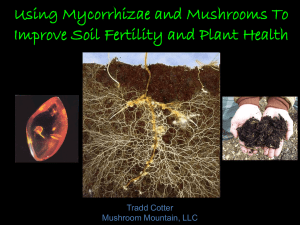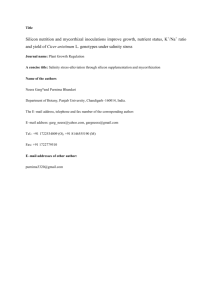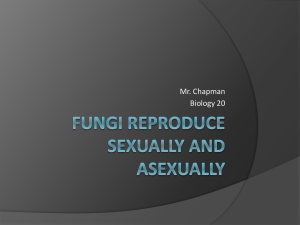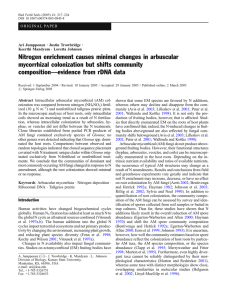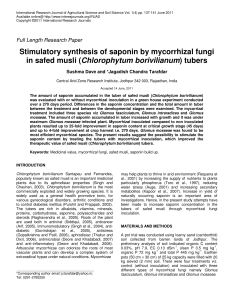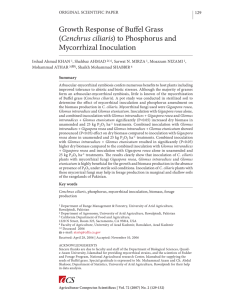submission template here.
advertisement
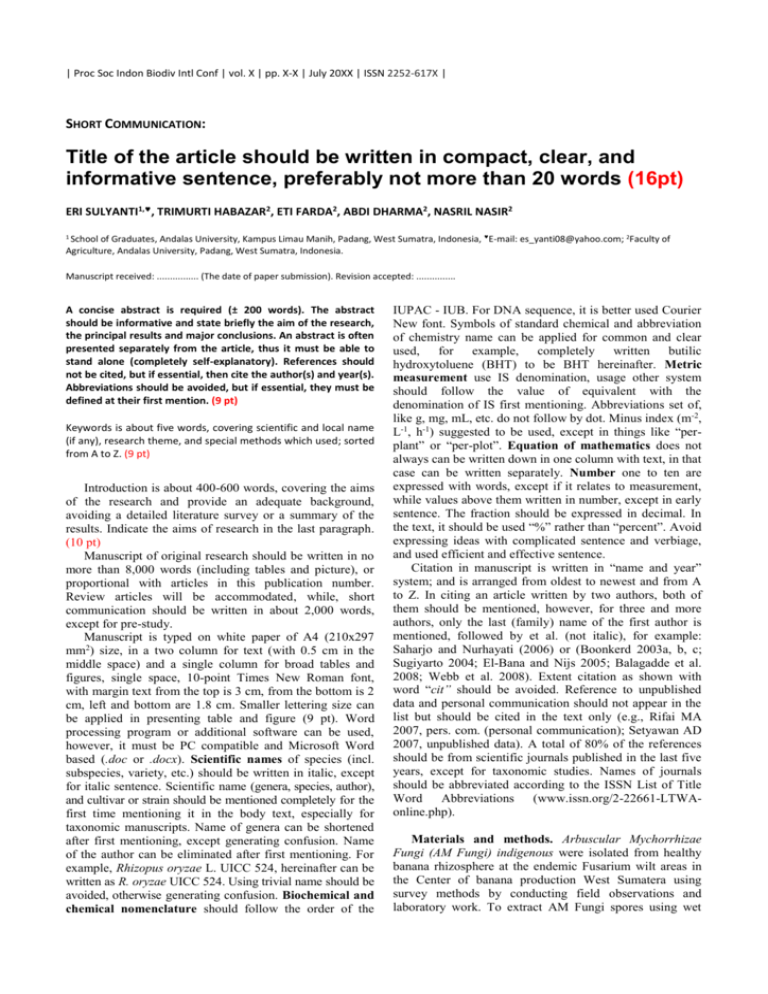
| Proc Soc Indon Biodiv Intl Conf | vol. X | pp. X-X | July 20XX | ISSN 2252-617X | SHORT COMMUNICATION: Title of the article should be written in compact, clear, and informative sentence, preferably not more than 20 words (16pt) ERI SULYANTI1,, TRIMURTI HABAZAR2, ETI FARDA2, ABDI DHARMA2, NASRIL NASIR2 of Graduates, Andalas University, Kampus Limau Manih, Padang, West Sumatra, Indonesia, E-mail: es_yanti08@yahoo.com; 2Faculty of Agriculture, Andalas University, Padang, West Sumatra, Indonesia. 1 School Manuscript received: ................ (The date of paper submission). Revision accepted: ............... A concise abstract is required (± 200 words). The abstract should be informative and state briefly the aim of the research, the principal results and major conclusions. An abstract is often presented separately from the article, thus it must be able to stand alone (completely self-explanatory). References should not be cited, but if essential, then cite the author(s) and year(s). Abbreviations should be avoided, but if essential, they must be defined at their first mention. (9 pt) Keywords is about five words, covering scientific and local name (if any), research theme, and special methods which used; sorted from A to Z. (9 pt) Introduction is about 400-600 words, covering the aims of the research and provide an adequate background, avoiding a detailed literature survey or a summary of the results. Indicate the aims of research in the last paragraph. (10 pt) Manuscript of original research should be written in no more than 8,000 words (including tables and picture), or proportional with articles in this publication number. Review articles will be accommodated, while, short communication should be written in about 2,000 words, except for pre-study. Manuscript is typed on white paper of A4 (210x297 mm2) size, in a two column for text (with 0.5 cm in the middle space) and a single column for broad tables and figures, single space, 10-point Times New Roman font, with margin text from the top is 3 cm, from the bottom is 2 cm, left and bottom are 1.8 cm. Smaller lettering size can be applied in presenting table and figure (9 pt). Word processing program or additional software can be used, however, it must be PC compatible and Microsoft Word based (.doc or .docx). Scientific names of species (incl. subspecies, variety, etc.) should be written in italic, except for italic sentence. Scientific name (genera, species, author), and cultivar or strain should be mentioned completely for the first time mentioning it in the body text, especially for taxonomic manuscripts. Name of genera can be shortened after first mentioning, except generating confusion. Name of the author can be eliminated after first mentioning. For example, Rhizopus oryzae L. UICC 524, hereinafter can be written as R. oryzae UICC 524. Using trivial name should be avoided, otherwise generating confusion. Biochemical and chemical nomenclature should follow the order of the IUPAC - IUB. For DNA sequence, it is better used Courier New font. Symbols of standard chemical and abbreviation of chemistry name can be applied for common and clear used, for example, completely written butilic hydroxytoluene (BHT) to be BHT hereinafter. Metric measurement use IS denomination, usage other system should follow the value of equivalent with the denomination of IS first mentioning. Abbreviations set of, like g, mg, mL, etc. do not follow by dot. Minus index (m-2, L-1, h-1) suggested to be used, except in things like “perplant” or “per-plot”. Equation of mathematics does not always can be written down in one column with text, in that case can be written separately. Number one to ten are expressed with words, except if it relates to measurement, while values above them written in number, except in early sentence. The fraction should be expressed in decimal. In the text, it should be used “%” rather than “percent”. Avoid expressing ideas with complicated sentence and verbiage, and used efficient and effective sentence. Citation in manuscript is written in “name and year” system; and is arranged from oldest to newest and from A to Z. In citing an article written by two authors, both of them should be mentioned, however, for three and more authors, only the last (family) name of the first author is mentioned, followed by et al. (not italic), for example: Saharjo and Nurhayati (2006) or (Boonkerd 2003a, b, c; Sugiyarto 2004; El-Bana and Nijs 2005; Balagadde et al. 2008; Webb et al. 2008). Extent citation as shown with word “cit” should be avoided. Reference to unpublished data and personal communication should not appear in the list but should be cited in the text only (e.g., Rifai MA 2007, pers. com. (personal communication); Setyawan AD 2007, unpublished data). A total of 80% of the references should be from scientific journals published in the last five years, except for taxonomic studies. Names of journals should be abbreviated according to the ISSN List of Title Word Abbreviations (www.issn.org/2-22661-LTWAonline.php). Materials and methods. Arbuscular Mychorrhizae Fungi (AM Fungi) indigenous were isolated from healthy banana rhizosphere at the endemic Fusarium wilt areas in the Center of banana production West Sumatera using survey methods by conducting field observations and laboratory work. To extract AM Fungi spores using wet SULYANTI et al. – Biocontrol agent to Fusarium wilt sieving methods (Figure 1; Gederman and Nicolson, 1963). The single spore of AM Fungi was introduced to 3 dayages of shorgum root to their limited propagation through make of culture starter and keep on test tubes (volume 50 g) for 30 days (Brundrett , et al. (1996) and mass propagation on maize seedling (pot cultures : volume 200 g) for 60 days. The AM Fungi isolates added to the roots of the banana planlet ( 10 g isolate per planlet) at planting time. Kultur starter FMA dipupuk dengan + 10 ml larutan 1% Hyponex merah (25-5-20) dengan konsentrasi 1 g L-1 setiap 3 hari sekali dan disiram sampai kapasitas lapang. Tanaman dipelihara hingga mencapai awal masa berbunga (+ umur 2 bulan) di rumah kaca FMA fertilized with starter culture + 10 ml solution of 1% red Hyponex (25-5-20) with a concentration of 1 g L-1 every 3 days and watered to field capacity. Plants maintained up to early flowering (+ 2 months of age) in a greenhouse The diversity of AM Fungi was observed by counting the number and types of spores per 100 grams of soil, carried out by identifying which are based on the shape and type of spores to genus level is done by making preparations microscope in Melzer's solution (Brundrett et al. 1996; Invam 2004). Results and Discussion. In this research found three genera of AM Fungi Glomus sp, sp Acaulospora sp, Gigaspora sp. From the low land areas (+ 70 m sea level) found 11 spore type of AM Fungi with 34 number of individual consisting of 8 Glomus sp.1, 7 Glomus sp Type 2, 2 Glomus sp.3, 1 Glomus sp.4, 1 Glomus sp.5, 2 Glomus sp.6, 1 Glomus sp.7, 3 Glomus sp.8 and 3 Acaulospora sp.1, 2 Acaulospora sp.2, 4 Gigaspora sp, while in the middle land (+ 475 m sea level) recorded 8 spore type of AM Fungi species with a total of 18 individuals consisting of 8 species, ie Glomus sp.1, 1 Glomus sp Type -3, 2 Glomus sp.4, 1 Glomus sp.5, 1 Glomus sp.6, and 1 Acaulospora sp.1, 2 Acaulospora sp.2 and 2 Gigaspora sp. In the high land (+ 975 m sea level) recorded 8 spore type of AM Fungi with 24 number of individual consisting of 7 Glomus sp.1, 6 Glomus sp.2, 2 Glomus sp.3, 1 Glomus sp.4, 2 Glomus sp Type -5, 1 Glomus sp Type -6, and 1 Glomus sp.7. Frequency of the presence of AM Fungi varies, the highest was Glomus sp ie 100.00%, followed by Akthar, M.S. and Siddiqui, Z.A. 2008. Arbuscular Mycorrhizal Fungi as Potential Bioprotectants against Plant Pathogens. In: Mycorrhizae: Sustainable Agriculture and Forestry, Siddiqui, Z.A., M.S. Akhtar and K. Futai (Eds.). Springer Netherlands, Dordrecht, The Netherlands, pp: 61-97. Brundrett, M.C. (2002). "Coevolution of roots and mycorrhizas of land plants". New Phytologist 154 (2): 275–304. Gianinazzi S, Schüepp H, Barea JM, Haselwandter K (2002). Mycorrhizal technology in agriculture: from genes to bioproducts. Birkhauser, Basel INIBAP. 1998. Evalluation of Musa germplation resistance to sigatoka disease and fusarium wilt. Montpellier. France. 5 Acaulospora sp and Gigaspora sp 66.66%. After trapping each of spores by using a single spore culture on sorghum seedlings was found 76 healthy spores as AM Fungi isolates. These AM Fungi isolates introduced to Maize seedling to select and reproduced them and found that 24 isolates of AM Fungi have the potential to be implemented on a banana seedlings to reduce fusarium wilt. Arbuscular mycorrhizal (AM) fungi are worldwide distributed soil fungi, forming symbiosis with most plant families. Their importance in natural and seminatural ecosystems is commonly accepted and materialized by improved plant productivity and diversity as well as increased plant resistance against biotic and abiotic stresses (Smith and Read 2008). Nowadays, they are increasingly considered in agriculture, horticulture, and forestry programs, as well as for environmental reclamation, to increase crop yield and health and to limit the application of agrochemicals (Gianinazzi et al. 2002; Johansson et al. 2004). Natural areas generally contain an array of mycorrhizal fungal species. The proportions and abundance of mycorrhizal species often declines following any disturbance. Not all mycorrhizal fungi have the same capacities and tolerances. Because of the wide variety of soil, climatic, and biotic conditions characterizing their environments, it is improbable that a single mycorrhizal fungus could benefit all banana cultivars and adapt to all conditions. For example, the types and activities of mycorrhizal fungi associated with banana cultivars are often different than those associated with woody plants. Mycorrhizal fungi have differing abilities to produce antibiotics that retard soil pathogens. Likewise, some mycorrhizal fungi are better at producing enzymes that facilitate mineral uptake such as phosphorous and iron. Still other mycorrhizal fungi can access organic forms of nitrogen. Selecting mycorrhizal products that contain several mycorrhizal species likely provides a range of benefits to the plant not found with only one species. Conclusion. AM Fungi diversity more predominantly found in lowland areas compared to Middle and highland areas with varying spore densities. Three genera of AM Fungi found were Acaulospora, Glomus and Gigaspora, whereas Genus Glomus found dominantly in almost all soil sampling sites. Invam. 2004. Classification of Glomeromycota. http://Invam.caf.wvu.edu/fungi/taxoniny/clasification.tm.on Mei 2005 Page 1 of 1 Johansson, J.F., Paul, L.R., and Finlay, R.D. 2004. Microbial interactions in the mycorrhizosphere and their significance for sustainable agriculture. FEMS Microbiol Ecol 48:1–13. Marschner, P., Timonen, S. 2004. "Interactions between plant species and mycorrhizal colonization on the bacterial community composition in the rhizosphere". Applied Soil Ecology 28: 23–36. Smith ,S.E., and Read, D.J. (eds). 2008. Mycorrhizal symbiosis, 3rd edn. Academic, London
